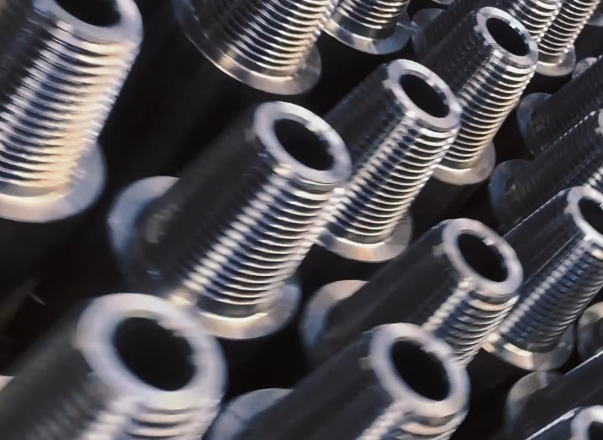Drill pipes are manufactured and used in the oil and gas industry following specific standards to ensure their quality, compatibility, and safety.This article delves into their manufacturing process, key specifications, and industry standards to help you better understand these crucial tools.
Manufacturing Process of API Drill Pipe with Upset
Drill pipes with upset ends are created through a forging process where the tube ends are made with thicker walls. The manufacturing begins by heating the ends of the steel tube. Once heated, pressure is applied using a closed die hydraulic forging press, which forms the upsets on the tube ends.
External Upset: The first step in the upset process involves forming an external upset with an outer taper at one end of the tube.
Internal Upset: Internal upset forging follows by pressing the external upset portion to create an internal taper. This process can be done using an internal upset die.
The upset process adds strength to the pipe's threaded connections, making it more suitable for high-pressure and high-strength applications. However, not all drill pipes are upset, as the process involves higher costs and technical complexity.
Drill pipe tool joints are enlarged and threaded ends welded to the pipe. They are designed to withstand the severe conditions of drilling, providing connections with high-strength and high-pressure threads. The tool joints are made separately from the pipe body and then welded onto the ends of the pipe, ensuring secure and reliable connections that can endure the mechanical stresses of drilling operations.
Each end of the drill pipe incorporates a tool joint, which consists of:
Pin (Male): The threaded male connection.
Box (Female): The threaded female connection.
These tool joints are heat-treated to a higher strength than the steel of the tube body, making them capable of surviving the rigors of repeated tightening and loosening during drilling operations.
Industry Standards for Drill Pipe
Drill pipes are manufactured following specific standards to ensure quality, safety, and compatibility. Some of the key standards include:
API Spec 5DP: This specification, set by the American Petroleum Institute (API), governs the manufacturing of steel drill pipes. It covers dimensions, mechanical properties, inspection requirements, and the use of various grades of drill pipes suited for different drilling applications. API Spec 5DP includes three product specification levels (PSL-1, PSL-2, PSL-3), with stricter requirements for higher levels.
ISO 11961: This international standard specifies the requirements for drill stem design and operational limits. It guides the selection of drill stem components, including drill pipes, and outlines mechanical properties, dimensions, and tolerances.
ISO 10424: This standard addresses rotary drilling equipment and covers specifications for drill stem elements, including drill pipes, in terms of dimensions, materials, and technical requirements.
DS-1® (Drill Stem Inspection Standard): While not a manufacturing standard, DS-1 provides guidelines for the inspection of drill stem components. It defines inspection methods to ensure the integrity and reliability of drill pipes and other components.
API Grade Drill Pipe
API SPEC 5DP specifies the technical delivery conditions for steel drill-pipes with upset pipe-body ends and weld-on tool joints for use in drilling and production operations in petroleum and natural gas industries for three product specification levels (PSL-1, PSL-2 and PSL-3). PS-1 specifies wall thickness, impact strength, and yield strength requirements specific to the material grade. Specification levels PL-2 / PL-3 have additional mandatory requirements.Drill pipe grades are specified to meet various operational demands. Some common API grades include:
E-75
X-95
G-105
S-135
|
API Drill Pipe Grade
|
Minimum Yield Strength (psi)
|
Minimum Tensile Strength (psi)
|
|
E-75
|
75,000
|
100,000
|
|
X-95
|
95,000
|
105,000
|
|
G-105
|
105,000
|
115,000
|
|
S-135
|
135,000
|
145,000
|
Grade E Drill Pipe
Grade E drill pipe, often referred to as "mild" steel, has the lowest yield strength among drill pipe grades, with a yield strength of less than 80,000 psi. Despite its lower strength, it offers a higher level of stretch or "strain" tolerance before fracture compared to higher-strength grades. Additionally, Grade E is more resistant to corrosion and cracking. It is typically used in medium-depth wells, ranging from 10,000 to 15,000 feet.
High Strength Grades (X-95, G-105, S-135)
Grades X-95, G-105, and S-135 are classified as high-strength grades, offering significantly increased yield strength. These grades are essential for servicing deeper wells where higher strength is required to withstand greater stresses and pressures.
API Spec 5DP details these grades, along with their specific requirements for wall thickness, yield strength, and impact strength. Higher grades are designed for more demanding drilling conditions, such as deep wells or high-pressure environments.
Types of Upset in Drill Pipes
The upset refers to the wall of the tool joint at the threaded connection. Drill pipes can feature three types of upset finishes:
Internal Upset (IU): The inside wall of the joint is thicker than the pipe wall.
External Upset (EU): The outside wall of the joint is thicker.
Internal-External Upset (IEU): Both the inside and outside walls of the joint are thicker.
Each type of upset offers specific benefits depending on the drilling conditions and the operational requirements.
Conclusion
Drill pipes with upset ends are crucial components in the oil and gas industry, providing the strength and durability needed to perform in harsh
drilling environments. By understanding the manufacturing process, key features such as tool joints and upset types, and the relevant industry standards, operators can make informed decisions to ensure the reliability and efficiency of their drilling operations.






 English
English Español
Español بالعربية
بالعربية











 Phone :
Phone :  Whatsapp :
Whatsapp :  Email :
Email : 


